Stitching Up Dreams
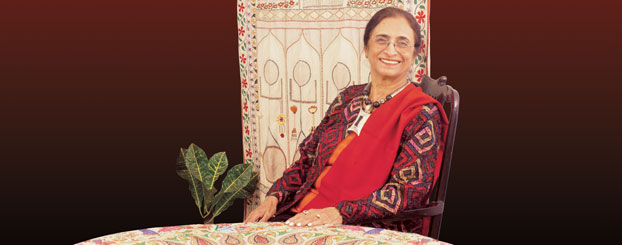
Her story reads like a combo of a fairy tale-cum-thriller where the heroine battles severe adversities and emerges triumphant. The feisty Shamlu Dudeja from Kolkata has seen it all in her 77 years; but overcoming every adversity she has brought happiness and pride in the lives of 1,000-odd women in rural Bengal. This she’s done by reviving and giving a new direction to Bengal’s traditional and exquisite Kantha embroidery. This after battling with a seven pound tumour in her stomach, followed by breast cancer. This Rotarian from RC Kolkata is indeed as feisty as she is creative, innovative and resourceful.
Born in Karachi before the Partition, she lived in a house near the Sindh Assembly and on August 14, 1947, “on the balcony of our house, I watched the white horse drawn chariot bringing Lady and Lord Mountbatten to the Sindh Assembly. They were received by (M A) Jinnah and his sister, and I saw the flag of Pakistan go up … I literally watched Pakistan’s birth,” she recalls.
Her father was a maths professor and initially hesitant, by October 1947 decided to move to India and “we came from Karachi to Bombay and then went to Delhi with just a suitcase of clothes and my mother’s sewing machine.”
Shamlu joined Lady Irwin School and was taught by her crafts teacher an embroidery stitch when she was 10; “but she didn’t tell us its name or background.” The girl often used that stitch to embellish her mother’s blouse sleeves.
In 1957, after graduating in maths honours, she shifted to Bombay and modelled for some time, making it to the cover of the Eves Weekly magazine and appearing for top brands such as Lakmé.
A modelling career
As modelling and organising 1,000 rural women are polls apart I quiz her on that phase; “well, I was slim and sexy then, but don’t write that,” she giggles, but later agrees to be quoted! In 1962 she married Vijay and they moved to Calcutta. “He was a junior executive and Calcutta was very welcoming and we made good friends here.” Within a year, their first child, Kabir was born. She started teaching at Miss Higgins, an elite private school, but when daughter Malika was born in 1968, she took a break, joining an international school to teach maths after four years.
In 1975 she got a scholarship to England to learn a new method of teaching Maths; the two-year-course being compressed to 6-months to accommodate the extremely talented teacher. On return she joined the Lorretto Teachers Training College; “everything went on very well till 1985 when they found I had a 7-pound tumour in my stomach, and I had to give up my job,” she sighs.
Rainbow after cloudburst
As she was recovering, at a local handicrafts meet she met a group of women from the villages around Shantiniketan, an event that changed her life. Intrigued by the stitch used in the women’s embroidery, and recalling its similarity to what she had learnt as a child in Delhi, she quizzed the women and learnt all about the significance of Kantha in Bengali culture. The interaction fired in her the idea to spread the craft and proved to be a dazzling rainbow after a cloudburst in her life.
Shamlu invited these women to her home and asked them to attempt similar work on new silk saris instead of old saris and gave them some Paisley and other patterns. Though initially reluctant and sceptical as this was totally different – working on a single layer of silk instead of multiple layers of old cotton they were used to – the women took up this challenge and returned after four months, all smiles.
She set about the task of setting up the SHE (Self Help Enterprise), but around 1987 before the women could return with the second set of saris, tragedy struck again; she was diagnosed with breast cancer. Her daughter Malika was about to go to UK for higher education, but stayed back to help her mother and got drawn into her mother’s dream. She actually took it forward by launching a range of Kantha kurtas and kurtis, which she marketed to her friends in college. While all this was happening, a publisher approached Shamlu to write Maths text books, and these continue to bring her royalty.
Both mother and daughter got engrossed in reviving this intangible cultural heritage of Bengal; apart from Shamlu, Tagore’s daughter-in-law and another woman were also trying to revive Kantha.
Kantha goes to London
Even as they got busy with innovations in silk / chiffon / georgette saris and dupattas and kurtas, Shamlu got a guest from London, “who said this is exquisite embroidery, why don’t you bring this work to London?”
Thus came SHE’s first overseas exhibition in London in 1990. “We put it up in her house which was across the road from the Victoria Albert Museum. Her windows were 17 ft high and we hung saris and curtains from her windows; several people visiting the museum saw these and came to her house.”
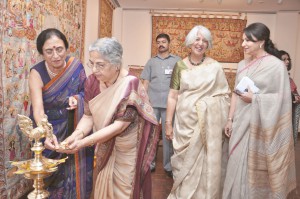
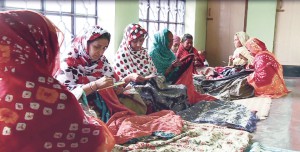
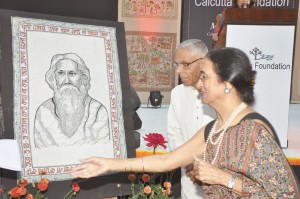
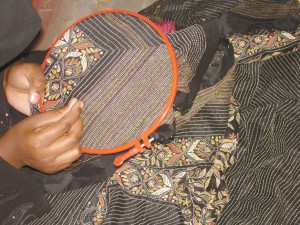
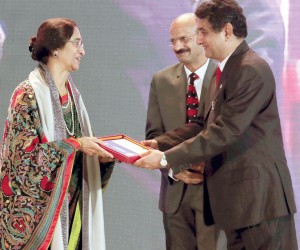
Origin
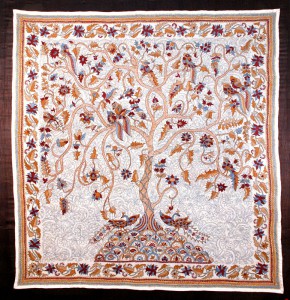
Kantha’s origin is not authentically chronicled but is believed to date back to the 16th century, the word itself originating from the Sanskrit word for rags. Born out of necessity and thrift, traditionally, in rural Bengal women in the family would put together used saris, dhotis and other fabrics and join the layers with Kantha stitches running over simple designs, converting the old and used fabrics to beautiful quilts, mats or soft wrappings for newborns.
As Leslie Umberger, an eminent curator who has curated exhibitions on international folk textiles at prestigious institutions such as the Smithsonian American Art Museum, and has specialised in folk arts and tradition of various cultures, including Kantha, writes in the introduction of the book Through the Eye of a needle brought out by Shamlu’s SHE (Self Help Enterprise), “Bengali tradition holds that old cloth is spiritually protective; babies swaddled in worn soft cloth were thought to be shielded from the evil eye. It also holds that joined rags symbolise the creating of a unifying whole.” Such exquisite fabrics were traditionally created by the women as auspicious gifts to celebrate family milestones including births and marriages; “fashioned literally to protect a family member from the cold, a stitched Kantha is also a vehicle of richly layered meaning. In addition to their spiritual components, Kantha was driven into being by a union of thrift and practicality, and, much like Japanese Boro or African American improvisational quilts, the early Kanthas were necessarily spontaneous in design, unbound by pattern or symmetry and always unique,” she adds.
So traditionally in Bengal, whenever there was a wedding or pregnancy in the family, all the women would enthusiastically get together to craft a loving garment for the son-in-law or the new born baby. “All women of rural Bengal have an inherent talent for stitching. Kantha embroidery is the expression of the innermost thoughts of rural women and we have inherited this intangible heritage from our mothers and grandmothers,” says a SHE team leader.
Factbox
- SHE Foundation was formalised as an NGO in 1999 to give Kantha artisans income at their doorstep and spread greater awareness about Kantha both within and outside the country.
- Currently SHE has access to about 1,000 artisans, though only 300 are members.
- The women work only for 2–3 hours a day at home in their spare time.
- Kantha products are sold at their showroom in Kolkata and through Jaypore, the online store.
Now of course her SHE’s Kantha exhibitions have gone to many European countries, Tokyo, Yokohama, Melbourne, etc and SHE is now getting a branch in France.
On the pricing overseas, Shamlu says it is barely double or a little more to just cover the cost of travel and stay, as the objective is to popularise this ancient craft of Bengal and not to make profits.
On the similarity between some of the Kutchi embroidery and Kantha, Shamlu says the stitches might have some similarity, “but it is not the same. We have to remember that in Bengal, in the good old days, Kantha was actually a quilting stitch. It was never embroidery.
But in Gujarat, Rajasthan and even Punjab it was always embroidery for embellishment. Here it was more a practical thing; recycling of old garments, which were softer to wrap babies, or use as quilts that felt soft against the skin. “It was all about making old into new; there were no artists to make the sketches so the women put their heart and soul into the work and would make a lion, peacock, tiger or people. It was not art work; it just came from the heart,” says Shamlu.
Small wonder then that what that work turned out to be was nothing short of spectacular. While the younger women made stitches to make a lion or tiger, the older women did just parallel lines or concentric circles. The SHE women, who affectionately call Shamlu ‘Didi’ or Boro Ma, now use cotton embroidery thread to make the stitches, but in the olden days, says Shamlu, “they would use threads pulled out from the border of the old sari or cloth as that thread is thicker. Now of course we use new fabric and thread.”
While the girls working on their Kantha fabrics have a great time as typically 3-4 or more girls/women will work on one sari or kurta, it is a kind of adda where they have chai as they work. The best part about this work is that it is not full time, it is done in the women’s own homes, so conservative families, particularly Muslims, have no problem with the women doing this work. As the women can manage to put in only two or three hours a day, it takes them four to five months to complete a sari. While a silk or chiffon sari costs from Rs 12,000-15,000 at the SHE showroom, kurtas and kurtis would typically cost around Rs 4,000-5,000 and dupattas around Rs 4,000.
Prestige, self esteem
So in economic terms, when the women make around Rs 600 or 700 a month, it is not big money. But the fact remains they are not full-time workers, they don’t need to commune as the SHE members specially designated with the work reach them the garments, designs and embroidery threads to their homes. “It’s much more than money for them. When we did the Tagore project at the Kolkata Raj Bhavan (where Kantha panels related to Tagore’s work were displayed) the women who got the award brought their entire families with them. For them it’s a matter of prestige, self-esteem and recognition,” says Shamlu.
And recently when Malika celebrated her mother’s 75th birthday she invited 90 women from nearby villages to have lunch at home. “It was a surprise party for me. They ate fish and prawns, sang and danced on the stage. It is a question of identity, belonging.”
And it works both ways. When Shamlu lost her son who was only 32, and who died in bed due to cardiac myopathy and later her husband, also from the same cause, it was the women from SHE, and her involvement with their work and lives that helped her cope with these tragedies. “These girls came to my house, stood by me, had lunch with me … and during that year our work doubled and we were able to sell much more,” she says.
The work is marketed through the outfit called Malika’s Kantha Collection and Trading. Shamlu takes a small salary for her expenses; “my math text books royalty gives me enough money. And money has never been my motive. Actually the maximum royalty for my maths books comes from my homeland Karachi, where the Oxford University Press had asked me to do a special series of book exclusively for them.”
As I interviewed Shamlu, her staff was busy packing the Tagore products – done specially for Tagore’s 150th birth anniversary – for an exhibition at Houston, where a small fashion show was being planned. She recalls that when Bill Clinton was US President she had sent Hillary Clinton a wall hanging through a friend. “She wrote me a letter saying she loved it. When she came to Kolkata two years ago, at a stall
I had put up at the Taj Bengal for her delegation, she came there, chatted with me, and bought a Tagore picture done in Kantha and presented it to our chief minister.”
Next morning there were pictures of West Bengal Chief Minister Mamata Banerjee waving the Tagore picture before the media, and the Kantha women got a big boost.
Shamlu’s “girls” swear by their Boro Ma and she says, “I can’t even put into words what these girls mean to me … except say they mean the world to me.” While the money they might make from this association might be modest, the Kantha women get help from association with SHE in terms of loans for education, health care, home extension, building of additional toilets, support for setting up printing units nearby, health and hygiene camps, and training in self-defence to ward off unwanted sexual advances. In some of the water deficient areas, tube-wells are also being put up for their families.
Amazing bonding
The bond that SHE has developed with these women is invaluable. In the beautifully brought out book, Through the Eye of a needle, the Kantha women of SHE have amazing tales to relate on their association with the organisation. One of them, Sadhana Mohan, proficient as a girl in Kantha kaaj, lost her right arm when she fell from the balcony. Devastated for some time, she began trying out the
Kantha stitch with her left hand, and later, with a loan from her husband, organised Kantha artisans in her locality and tried to sell their work in local fairs but with little success. Later she hooked up with SHE and became an integral part. Once while travelling to the US with Shamlu for an exhibition, British Airways lost her baggage and for the entire duration of her stay “Didi took care of everything and even shared her clothes with me.”
Dipti Poddam, another team leader, describes in the book how she had become proficient in Kantha work from a young age and loved working with Shamlu and her network. When she got married, “Didi came with a tray full of gifts; she even helped my husband to get a permanent job in the BSF and gave us financial stability.” She describes how unmarried girls are able to put a lot more time into this work and get a better income and most of them use this money to buy jewellery for their wedding. As she got busy raising a family, Dipti had to give up Kantha, but never lost touch with SHE. Now that her children are 21 and 16, she wants to get back but is deterred by her failing eyesight. What is touching is her confidence that, “SHE will help me with the treatment for my eyes,” just as it had helped buy a computer for her children!
But the clincher in this account is how Shamlu always treated her like Malika; being firm when required but “indulgent” most of the time!
Shamlu’s ultimate goal while promoting Kantha all over the world is interesting. “Just as the peacock is the national bird of India, I want to make Kantha the national stitch of India. I want Prime Minister Narendra Modi’s help to do this. When he says ‘Make in India’ what more can be made in India than Kantha fabrics?”
Meanwhile this Rotarian for 22 years also wants “Rotary to help my girls take Kantha all over the world.”
